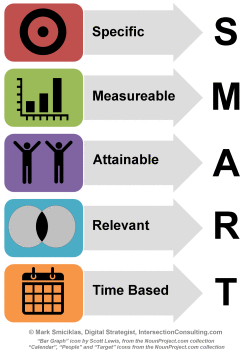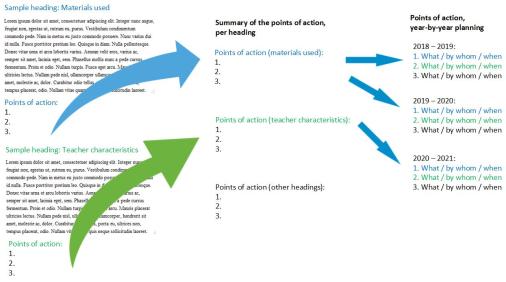Now that you’ve created a complete picture of the language curriculum, it’s time to make a list of “Points of Action” for each section of the language policy. Points of Action are things that need to be done, in order to realize the ideal English program. These actions may be big or small, as long as they contribute to the end goal. When you write a Point of Action, write it using the “SMART” method. Make it Specific, Measureable, Attainable, Realistic, and Time-based. If the Point of Action is rather large, you may wish to break it up into smaller, realistic steps.

For instance, a sample point of action might be “Teachers need more information on how to make better lessons.” When you write this, ask yourself: “What is better? What kind of information do they need? Why do they need this?” Clearly, this point of action is not SMART. To make it SMART, make it more Specific: if the teachers want their lessons to be more interactive, for instance, with more student talking time, then the point of action can be adjusted like this: “Teachers need means to adapt their lessons to allow for more student talking time.”
This is still a very big point of action, which can be sub-divided into smaller, easily-attained tasks. Think about steps like the following:
- Orientation: what kinds of lesson adaptations are there?
- Examination: trying out various lesson adaptations
- Evaluation: talking about the effectiveness of the various adaptations
- Determination: deciding which lesson adaptations to keep and which to let go
- Safeguarding: making sure the new adaptations remain in place
Once you’ve checked (and double-checked!) your points of action, it’s time to put it all together into one, final Plan of Action. Start by bringing the points from each chapter together into one summary, per heading (see illustration below). Talk with your director and find out which points need to be an absolute priority, and decide on a logical order of steps to be taken. Also, have a good look at the timeline. How many years will be needed to realize the goals put forth in the policy plan? Perhaps three is sufficient, but it’s also likely that more may be needed.
After that, set the points of action into the year-by-year overview. Make sure that each point of action is attainable (not too big!), and part of the bigger plan. Decide who will be responsible for each point of action, and plan a reasonable deadline for each point. If money is needed, look at possibilities for subsidies from local and national agencies. This will be different from place to place, of course.

Another important point of action that must be remembered is to evaluate the plan at some point every year. Have a look at what goals were reached, which need to be amended, and congratulate everyone for any progress made. After all, when it comes to curriculum improvement, it’s all hands on deck! Everyone contributes in his own way, according to his own talents.

Whatever you do while writing your policy plan, be aware that for some, simply opening up the conversation about the English program is already a big step. For others, making space for each teacher to contribute to an improved program will be the challenge. Each school has its own road to take in writing and carrying out a language policy plan. So yes, please talk with other people who have written a plan and carried it out, but realize that each road is unique, with its own twists and turns.
So take a deep breath and …. good luck!

